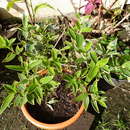en
names in breadcrumbs


Tibouchina /ˌtɪbuːˈkaɪnə/[2][3] is a neotropical flowering plant genus in the family Melastomataceae.[4][5][6] Species of this genus are subshrubs, shrubs or small trees and typically have purple flowers.[7] They are native to Mexico, the Caribbean, and South America where they are found as far south as northern Argentina.[1][7][8] Members of this genus are known as glory bushes, glory trees or princess flowers. The name Tibouchina is adapted from a Guianan indigenous name for a member of this genus.[3] A systematic study in 2013 showed that as then circumscribed the genus was paraphyletic,[4] and in 2019 the genus was split into a more narrowly circumscribed Tibouchina, two re-established genera Pleroma and Chaetogastra, and a new genus, Andesanthus.[9]
Tibouchina species are subshrubs, shrubs or small trees. Their leaves are opposite, usually with petioles, and often covered with scales. The inflorescence is a panicle or some modification of a panicle with reduced branching. The individual flowers have five free petals, purple or lilac in color; the color does not change as the flowers age. There are ten stamens, either all the same or dimorphic, with five larger and five smaller ones. The connective tissue below the anthers of the stamens is prolonged and modified at the base of the stamens into ventrally bilobed appendages. When mature, the seeds are contained in a dry, semiwoody capsule and are cochleate (spiralled).[9]
The genus Tibouchina was established by Aublet in 1775 in his Flora of French Guiana with the description of a single species, T. aspera, which is thus the type species.[10][11] In 1885, in his treatment for Flora brasiliensis, Alfred Cogniaux used a broad concept of the genus, transferring into it many of the species at that time placed in Chaetogastra, Diplostegium, Lasiandra, Pleroma and Purpurella, among others. This broad concept was generally adopted subsequently, and around 470 taxa were at one time or another assigned to Tibouchina.[9]
A phylogenetic analysis in 2013 based on molecular data (2 plastid and 1 nuclear regions) determined that the traditional circumscription of Tibouchina was paraphyletic. Four major clades were resolved within the genus which were supported by morphological, molecular and geographic evidence.[4] Based on the traditional code of nomenclature, the clade that the type species falls in retains the name of the genus; therefore, the clade containing Tibouchina aspera remains Tibouchina.[12]
A further molecular phylogenetic study in 2019 used the same molecular markers but included more species. It reached the same conclusion: the original broadly circumscribed Tibouchina consisted of four monophyletic clades. The authors proposed a split into four genera: a more narrowly circumscribed Tibouchina, two re-established genera Pleroma and Chaetogastra, and a new genus, Andesanthus. The relationship between Chaetogastra and the genus Brachyotum differed between a maximum likelihood analysis and a Bayesian inference analysis: the former found Brachyotum embedded within Chaetogastra, the latter found the two to be sisters. The part of their maximum likelihood cladogram which includes former Tibouchina species is as follows,[9] using their genus names and with shading added to show the original broadly circumscribed Tibouchina s.l.:
Tibouchina s.s.
Pleroma
clade 1 (other genera)
clade 2 (other genera)
Andesanthus
Chaetogastra / Brachyotum
As re-circumscribed, Tibouchina is monophyletic and contains species belonging to the traditional sections T. section Tibouchina and T. section Barbigerae.[10][4] Diagnostic characteristics include the presence of scale-like trichomes on the hypanthium and leaves and a long pedoconnective on lilac anthers, and the absence of glandular trichomes.[10][13][4] Species are found in savanna habitats.[10]
As of May 2022, Plants of the World Online accepts the following species within Tibouchina:[1]
Species placed in Tibouchina in its former broad sense include:
All the species of Tibouchina are native to the Americas as far north as Mexico south to northern Argentina,[1] with many found in Brazil,[4] and others in Belize, Bolivia, Brazil, Colombia, Costa Rica, French Guiana, Guyana, Honduras, Nicaragua, Panama, Peru, Suriname, and Venezuela.[1] Members of Tibouchina tend to be found in lowland savannas and on the lower slopes of the Andes.[4][14] All Tibouchina species as well as those formerly placed in the genus are considered noxious weeds in Hawaii,[15] because of their high potential for being invasive species.[16][17][18] Many species, such as T. araguaiensis, T. papyrus, T. mathaei and T. nigricans, have narrow distributions, being known from only a handful of locations, while a few other species, including T. aspera, T. barbigera and T. bipenicillata, have broader distributions.
{{cite web}}: CS1 maint: archived copy as title (link), cited 5 February 2007) Tibouchina /ˌtɪbuːˈkaɪnə/ is a neotropical flowering plant genus in the family Melastomataceae. Species of this genus are subshrubs, shrubs or small trees and typically have purple flowers. They are native to Mexico, the Caribbean, and South America where they are found as far south as northern Argentina. Members of this genus are known as glory bushes, glory trees or princess flowers. The name Tibouchina is adapted from a Guianan indigenous name for a member of this genus. A systematic study in 2013 showed that as then circumscribed the genus was paraphyletic, and in 2019 the genus was split into a more narrowly circumscribed Tibouchina, two re-established genera Pleroma and Chaetogastra, and a new genus, Andesanthus.